and historical purposes, all rights reserved.
This page is copyright© by
This page may not be sold or distributed without
the expressed permission of the producer.
I have no connection with any camera company.
Chinon CE Memotron
Chinon CE II Memotron
Alpa Si 2000 clone
RevueFlex 5005
Porst Reflex M-CE
Sears 2000 ES
This
camera manual library is for reference
and historical purposes, all rights reserved.
This page is copyright© by
![]() ,
M. Butkus, NJ.
,
M. Butkus, NJ.
This page may not be sold or distributed without
the expressed permission of the producer.
I have no connection with any camera company.
On-line camera manual library
Back to main on-line manual page
If you find this manual useful, If you use Pay Pal, use the link below.
CLICK HERE FOR CE MEMOTRON
CLICK HERE FOR TEXT AND IMAGES
For a listing of differences of Chinon CE / CE II / CE III models Type
35mm Single Lens Reflex Camera with electronically controlled
exposure system, fully automatic aperture-priority type.
Picture size 24mm x 36mm.
Film
35mm cartridge film.
Lens mount Pentax/Praktica mount.
Viewfinder visibility 92% of negative size.
Mirror Quick return system.
Shutter Metal focal plane, vertical path, electromagnetically
controlled.
Shutter speeds Auto 2 sees - 1/2000 sec (stepless). Manual B,1 sec-1/2000 see, and "X". Mechanical shutter operation at ''X" (1/90 see).
Film wind Single stroke in an arc of 134° with 20° play.
Film counter
Automatically indicates number of exposures and resets to zero when the camera back is opened.
Self-timer 6-10 seconds.
Exposure memory Push button with lock in conjunction with shutter release button.
Indication by a green signal lamp. Film rewind Folding crank type.
Accessory shoe Built in hot shoe.
Synchronization FP and X (X=1/90 see).
Multiple exposure Multiple exposure provision.
Power source 6V silver oxide battery (Eveready No. 544 or equivalent).
Viewfinder blind Built in viewfinder blind to prevent extraneous light from affecting the meter reading when the camera is used away from the eye.
Battery test Indication by a green signal lamp.
Dimensions (Body only) 145mm (W) x 97mm (H) x 54.5mm (D).
Weight
(Body only) 760 gr. (click on image below to enlarge image)
BASIC PROCEDURES
This should be a Duracell 28A 6v battery, about $6 in 2019. To install battery: (CLICK ON FIGURE LINKS TO SEE THE IMAGES)
1. Using a coin, unlock the battery chamber cover by turning it counterclockwise.
2. Place the 6V silver oxide battery with the minus ( - ) side facing upwards as indicated by the symbol in the battery chamber
(Fig. 1).
3. Replace the battery compartment cover by turning fully clockwise
(Fig. 2). This should be a Duracell 28A 6v battery. Note:
To test battery:
Test the battery when:
To test the battery, set the shutter speed dial to the "Auto" position
(Fig. 3). Wind the film advance lever and press the shutter release button half way. If the battery is in good condition, the green lamp in
the viewfinder frame will go on. When the green lamp does not go on, replace the battery (Fig. 4, 5).
Note:
Use 20 or 36-exposure 35mm film. 2. Keep the film rewind knob pulled all the way out, insert the film cartridge into the film chamber with the protruding end towards the base of the
camera. Push in the film rewind knob (Fig. 7)
Note: Do not load or unload the camera in bright sunlight. Note: When the shutter release button lock lever is engaged, the shutter cannot be released. Turn the
lever to the left to unlock
(Fig. 11).
Important:
The CHINON CE II Memotron camera is equipped with an electromagnetically controlled shutter for either automatic or manual exposure control.
To set the camera for automatic shutter speed selection rotate the shutter speed dial until the ''Auto" mark is opposite the index line on the camera body
(Fig. 13). To set it for manual exposure control, turn the shutter speed dial until the desired shutter speed is lined up with the index mark on the
camera body.
The distance scale may also be used for focusing.
Estimate or measure the camera-to-subject distance in feet or meters, then set the focusing ring to this figure
(Fig. 19).
Exposure Meter Needle
Over exposure will be indicated by the meter needle moving into the upper striped area of the viewfinder scale (Fig. 22). Should this occur the lens
aperture must be reduced until the needle enters the shutter speed scale. If the needle will still not enter the scale a neutral density filter must be used.
3. Under exposure:
Under exposure will be indicated by the meter needle moving into the lower striped area of the viewfinder shutter speed scale
(Fig. 24). To compensate open up the lens aperture until the needle moves back onto the scale. Should the needle still not re-enter the scale additional
lighting or a flash unit must be used.
When the red figure " 20 " or " 36 " (20 or 36 exposures) appears against the index mark in the frame counter window, the end of the film has been reached.
Steps for Unloading the Camera:
2. Lift up the rewind crank on the rowing knob
3. Turn the rewind crank in a clockwise direction (Fig. 26).
Tension will be felt as the film is being rewound into the cartridge. Stop rewinding when the tension ceases. Open the camera back by pulling out the
rewind knob all the way and lift out the film cartridge (Fig. 27). The CHINON CEII Memotron is equipped with a thread mount which accepts any interchangeable lens with the
Pentax/Practica thread mount. To remove the lens, keep turning the lens counter clockwise until it is separated from the camera body (Fig. 28,
29).
Note: Do not remove or replace the lens while camera is functioning.
In normal use the
CHINON CE II Memotron
will produce perfectly exposed photographs, due to the automatic exposure system
incorporated in the camera.
However some lighting conditions will occur that could misguide the system.
Subjects with very high contrast or strongly back-lit are examples. Such misguidance occurs with electronic shutter cameras since the exposure system
continuously
follows the fluctuations of light intensity up until the very instant that the exposure is made. To overcome these conditions a memory lock has been
incorporated.
Steps for using the exposure memory:
1. Focus the subject. Make sure that the shutter speed dial is set at the "Auto" position.
2. Press the shutter release button half way and measure the light on the main part of the subject
you want to shoot. excluding all unnecessary light from the side or background (Fig. 30, 31, Fig. 32). Then press the exposure
memory button which will instantly memorize the light value on the subject (Fig, 33)
and twist the memory button backward until it is locked. When the memory button is locked, the green lamp in the viewfinder will go on. After the exposure return the memory button to its original position.
Note:
The exposure memory system will be erased by releasing the exposure memory button before shooting. The memorization only functions by
simultaneous operation of the shutter release button and the exposure memory button.
For special purposes such as multiple exposure,
exposure compensation can be accomplished by resetting the ASA/DIN dial. The following guide will be
found useful in determining the correct length of exposure (Fig. 38)
(1) white index 2/3 over exposure
(2) white index 1/3 over exposure (Fig. 36)
(3) red index 1x correct exposure
(4) white index 1/3 under exposure
(5) white index 2/3 under exposure (Fig. 37)
As an example if over exposure to the extent of x 2/3 is required, set 100 ASA to the red index (1).
With this method it is possible to compensate from 40 to 250 ASA (Fig. 38).
After the exposure has been made the ASA number must be returned to the red index mark.
By moving the shutter speed dial off the "Auto'' setting manual shutter speeds are set. There are two methods of selecting the correct exposure.
1. Set the required shutter speed on the dial. While depressing the shutter release button observe the meter in the viewfinder. Rotate the lens aperture
ring until the needle aligns with the corresponding shutter speed figure on the scale in the viewfinder (Fig. 39).
2. Set the required aperture on the lens. Slightly depress the release button and observe which shutter speed is indicated in the viewfinder. Set this speed
on the shutter speed dial.
The Manual shutter speeds can be used for:
2. Exposure compensation.
3. '' B " (" Time'' exposures longer than that possible in the Auto mode).
4. Flash synchronization (''X'').
Caution: Get into the habit of immediately returning the shutter speed dial to the "Auto'' position after using the manual mode to avoid possible future
incorrect exposures (Fig. 40).
Mechanical shutter operation:
Since the "X'' (1/90 see) position employs a mechanical shutter, it is usable even when the battery is dead. Setting the shutter speed dial to the "X''
position whenever loading the camera with film or operating the shutter in an unloaded camera will also save unnecessary battery retrain:
This feature enables making double or multiple exposures on a single frame of film.
Depress the shutter release to make a second exposure on the same frame. Operating the shutter release returns the multiple
exposure knob automatically to its original position to prevent accidental multiple exposures. If a third exposure is desired on the same frame, just move
the multiple exposure knob to the left once more, operate the film advance lever to wind the shutter, then depress shutter release. This procedure can be
repeated to obtain any number of exposures on the same frame of film.
Depth of field designates the nearest and furthest limits of the area that will be sharp in the picture in front of and beyond the subject. Depth of field
is controlled by the f/stop. The larger the lens opening (f/stop), the shallower is the depth of field. The smaller the lens opening, the greater the depth of
field will become (Fig. 42, 43).
Visible check in the viewfinder:
Set the lens at selected lens opening on the F stop ring. Depress the shutter release button half way and observe the subject through viewfinder. This will
enable you to preview the area of sharpness in the picture before shooting.
Depth of field scale:
The depth of field scale indicates (after focusing) the approximate area that will be sharp in the
picture. Locate on the depth of field scale the corresponding pair of f/stop figures. The distance between these two f/stop figures on the focusing ring will
be the area of sharpness in your picture. (Fig. 44)
To operate, move the self-timer lever counterclockwise as far as it will go.
Advance the film transport lever. Upon pressing the shutter release button the self timer mechanism will start to operate. (Fig 45, 46). If the self-timer is used in the "Auto" mode, turn the viewfinder blind lever clockwise, closing the viewfinder system and thereby preventing extraneous light from influencing the metering system
(Fig. 47).
Electronic flash units as well as conventional flash units using flashbulbs may be utilized. The CHINON CE II Memotron has a hot shoe (accessory shoe with
built-in flash contact) together with standard P.C. outlets for ''X'' and '' FP'' synchronization. (Fig. 50)
Your CHINON CE II Memotron Single Lens Reflex Camera is a precision instrument. Used with care, it will provide years of service.
Protect our camera from dirt, rain, dampness, and excessive heat. Avoid touching the lens. To clean the lens wipe it gently with
a soft, lintless
cloth or tissue. Do not use eyeglass cleaners as they might damage the lens coating. CHINON Interchangeable Lenses
F/3.5 f=21mm AUTO
F/2.8 f--35mm AUTO
F/2.8 f=100mm AUTO
F/2.8 f=135mm AUTO
F/1.8 f=135mm AUTO
F/3.5 f=200mm AUTO
F/4.5 f=300mm AUTO
F/8 f=500mm (Mirror)
F/5.8 f=90-190mm AUTO*
F/3.5 f=75-205mm AUTO*
F/4.5 f=70-230mm AUTO
F/4.5 f=55-300mm AUTO
CHINON Standard Lenses
F/1.7 f = 55mm
F/1.4 f = 55mm
F/1.2 f = 55mm
*With a single control ring for zooming and focusing.
CHINON Accessories
Auto-Extension rings
Mini-Copy stand
Table tripod
Angle finder
Bellows
Rubber eyepiece
Rubber lens hood (52mm)
Rubber lens hood (55mm)
Wrist strap
Filter (52mm) IA, UV, Y2, ND`, PL
Filter (55mm) IA, UV, Y2, ND`, PL
Cable release (20 inch)
Cable release (13 inch)
Eyepiece adaptor --2.5 Dioptor
Eyepiece adaptor +1.0 Dioptor
Eyepiece adaptor +3.5 Dioptor
Body cap
Lens mount cap
Because we continually strive to improve our product we may change
specifications without prior notice.
how about a donation of
$3 to:
M. Butkus, 29 Lake Ave.,
High Bridge, NJ 08829-1701
and send your e-mail
address
so I can thank you.
Most other places would charge
you $7.50 for
a electronic copy
or $18.00 for a hard to read Xerox copy.
buy new manuals, and pay their shipping costs.
It'll make you feel better, won't it ?
Use the above address for a check, M.O. or cash.
PDF MADE FROM MANUAL
This is the early 42mm thread mount model
FROM OTHER LANGUAGES
Chinion CE II
Bedienungsanleitung
Chinon CE II mode d'emplio
Chinon CE II Instrucciones
Chinon CE istruzioni
The new model was built on the Chinon CE II Memotron with M42-screw-mount.
The metamorphosis from Chinon to ALPA was
accomplished through a few deft changes on the outside of the camera. Brilliant marketing idea or an own-goal against the image of
a superior brand? In any case, this escapade ended when both the Si 2000 and its successor
the Si 3000
with K-bayonet-mount (introduced 1980 and based on the
Chinon CE-4) ceased production some years later.
-- Information taken from another web site --

Exposure meter
TTL center weighted measuring system employing two Silicon blue cells.
Automatic exposure range of EV 0-19 with ASA 100 (2 sees at f/1.4 to 1/2000 see at f/16).
ASA range 25 - 3200.




About $6 in 2019
Clean the battery with a dry cloth or paper before inserting and thereafter at regular intervals. Make sure that the battery is inserted correctly, i.e.
check polarity.
The shutter will operate only when a battery is installed, except for the ''X'' (1/'90 sec.) position.
A new battery is installed.
The camera is not used for a long period of time.
The camera is being used continuously for many hours.


Every time a photograph is taken in the auto mode, the green lamp should go on, indicating that the battery is still in good condition. When the indicator
lamp fails to go on, replace the battery at once.

1. Pull out the film
rewind knob until the camera back is released, (Fig. 6) then swing the camera back fully open.
It may be found necessary to turn the knob slightly so that the rewind shaft engages the film cartridge spool. Insert the trimmed end of the film into the
slot of the take up spool. Holding the film lightly down onto the transport sprockets, operate the film advance lever. Having checked that the upper and
lower film perforations have engaged the transport sprockets. close the camera back firmly (Fig. 8).


To make sure the film has been loaded properly, operate the film advance lever through a full stroke
(Fig. 9). Now turn the rewind knob clockwise until resistance is felt. Do not force it. Keep observing film rewind knob; it
should turn counterclockwise every time the film is advanced.
Operate the film advance lever and release shutter until figure "1 " is opposite the pointer in the frame counter window. The camera is now ready for
the first exposure (Fig. 10).

Set the shutter speed dial to the "X" position when making two blank exposures to dispose of the first few inches of film which were exposed during
loading. After the film counter indicates you are ready to take the first exposure, be sure to return the shutter speed dial to the "Auto'' position.

The ASA/DIN speed of the film is indicated on the film box or in the instruction sheet packed with
the film. Select the desired ASA/DIN speed the ASA selection pin until the appropriate ASA number appears in the ASA dial window, (Fig. 12)
and then align the ASA/DIN number with the white index line on the camera top cover by turning the ASA/DIN dial.

The aperture is set in the usual way by rotating the lens aperture ring until the required F-stop is
set against the red diamond index, mark on the lens barrel (Fig. 14). With the shutter speed dial set at "Auto" the electronic metering
system will set the corresponding shutter speed to ensure correct exposure of the film.

Set the AM (Auto/Manual)
lever on the lens to the "Auto" position (Fig.15, 16).
Observing the subject through the viewfinder, turn the focusing ring on the lens until the image in the microprism disc in the center of the viewfinder appears
crisp and clear (Fig. 17,18). Once this point is reached it is advisable to continue turning the ring through the area of sharpest focus and
then back again. This procedure ensures without doubt that the image is at its sharpest.

Scale focusing

The meter on/off
switch is incorporated in the winding mechanism. It is therefore necessary to advance the film advance lever before proceeding. Set the shutter speed dial to
''Auto"
(Fig. 20) and select the aperture according to your purpose for shooting the picture. Focus the subject. Depress the shutter release button as slowly and
smoothly as possible. When the shutter release button is half way depressed, the exposure meter needle will indicate the correct shutter speed figure according
to the light value which corresponds to the chosen aperture value (Fig. 21). Further depression of the shutter release button
will release the shutter at the shutter speed indicated in the viewfinder.
1. Over exposure:


2. Correct
exposure:
While the exposure meter needle stays within the scale (arrow marked) correct exposure will result. It will be found when handling the camera that
automatic shutter speed selection is a function of the aperture and the ASA values chosen. As the lens aperture is altered the shutter speed will alter
accordingly. Therefore if the camera selects a speed that is considered unsuitable for the subject to be photographed, altar the aperture until a
suitable shutter speed is selected.
Should the meter needle move below 1/30 sec. then the use of a tripod is recommended, providing that a larger aperture cannot be set (Fig.
23).

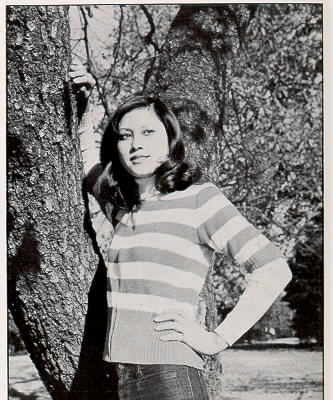
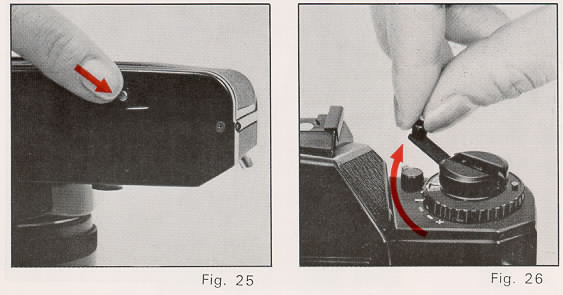
1. Press in the rewind release button on the camera bottom (Fig. 25).
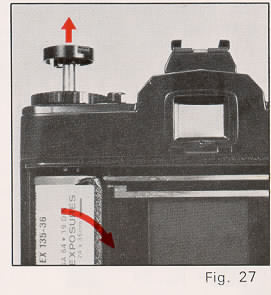
The rewind button on the camera bottom will snap back into position when the film advance lever is next operated. Have the fun.



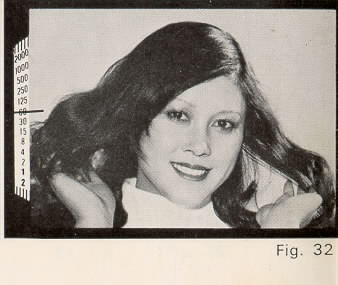
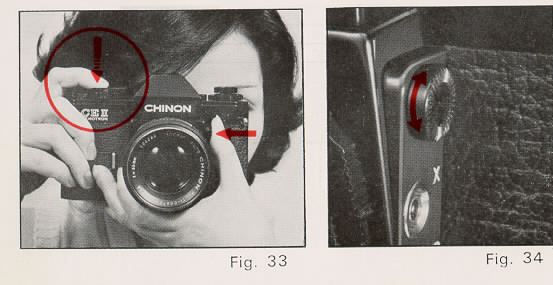
When the memory button is released the green lamp is turned off.
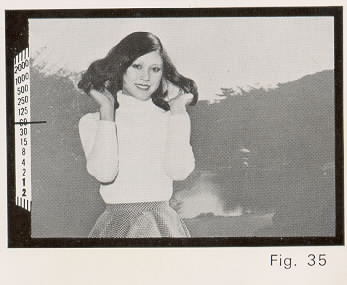
3. With the exposure
memory button locked compose the subject in the viewfinder as you desire (Fig. 35). and press the, shutter release button all the way to take the
photograph.
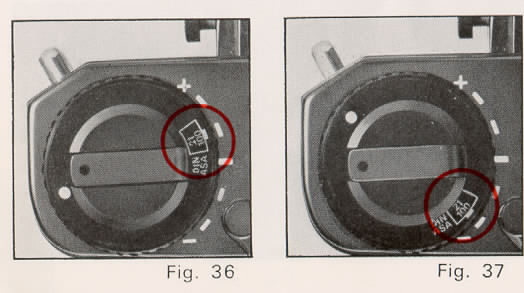
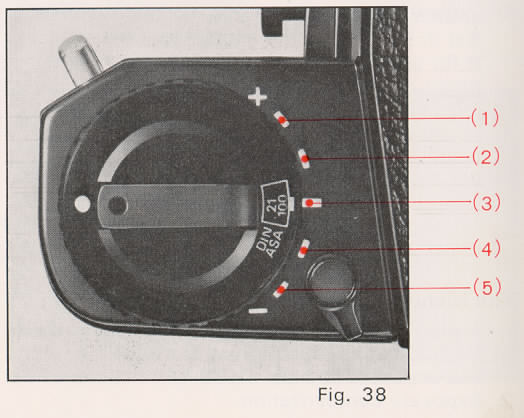
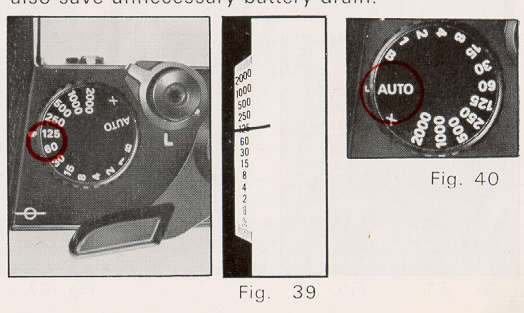
If for special purposes it is necessary to either under or over expose the photograph, proceed by either of the previous methods. Then rotate the lens
aperture ring to bring the meter needle above the shutter speed indicated in the viewfinder. This will produce over exposure.
Conversely if the needle is brought below the indicated shutter speed then under exposure will result.
1. A particular shutter speed that is required and beyond the coupling range of the meter, e.g. 1 sec exposure at 3200 ASA.

When desired, the shutter can be wound without transporting the film.
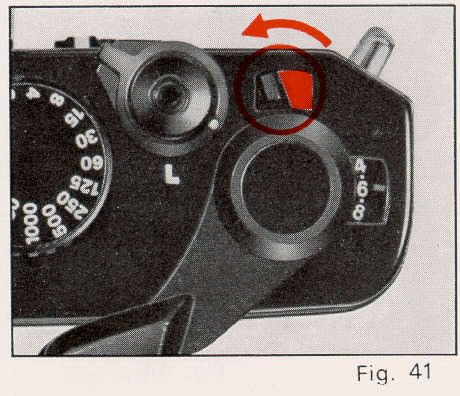

Take the first picture in the normal way. Before moving the film advance lever, slide the multiple exposure switch to the left, as far as it will go
(Fig. 41). A red signal appears in the window indicating that the film advance lever can be wound, but it will only wind the shutter and not transport the film.

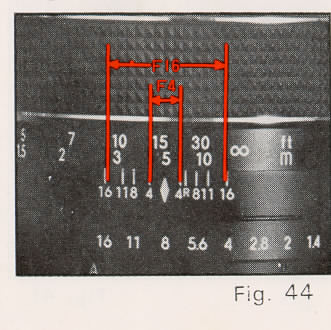
This device, when set, trips the shutter mechanism after a delay of 6- 10 seconds. It is necessary if the photographer wishes to be in the picture, and is
useful for tripping the shutter at a slow shutter speed if a cable release is not available.
When using the self-timer the camera must of course be mounted on a tripod, or a solid support of some kind.

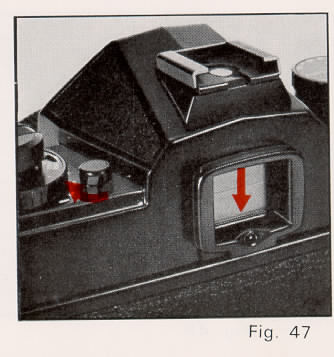
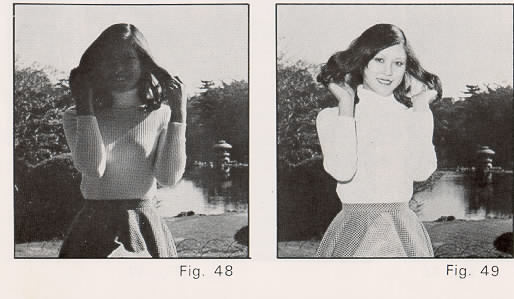
It is advisable to use flash when the exposure meter indicates that the light level is too low, such as
indoors, at night time, or in daylight where the subject is
too dark to provide adequate exposure (Fig. 48, 49).

Electronic and conventional flash units having a foot with built-in contact may be used without a connecting cord.
As the hot shoe has ''X ''type
synchronization, it can be used with electronic flash at ''X'' (1/90) (Fig. 51)
or at slower shutter speeds, the lens
aperture is determined by the calculation table indicated on flash units.
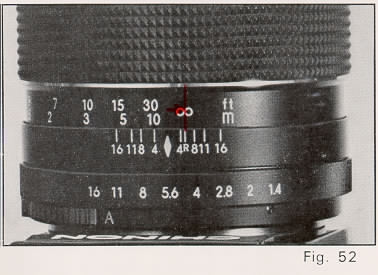
To use infra-red film an extra focusing adjustment must be made. After focusing note the figure that
is adjacent to the red diamond on the distance scale then move that figure over to the red " R " marked to the right side of the red diamond.
(Fig. 52) This adjustment is only required for black and white infra-red film. When using color infrared film, focus in the normal way.
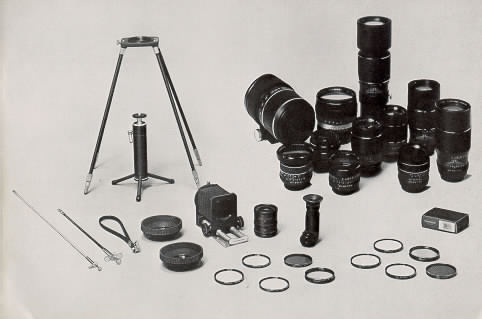
F/2.8 f=2.8mm AUTO